Key takeaways:
- Urban gardening fosters a connection to food sources and promotes creativity in utilizing available space.
- Choosing the right plants based on sunlight, climate, and companion planting enhances gardening success.
- Implementing sustainable practices, like composting and water conservation, positively impacts both plants and the environment.
- Harvesting and sharing produce not only provides fresh flavors but strengthens community bonds through shared experiences.
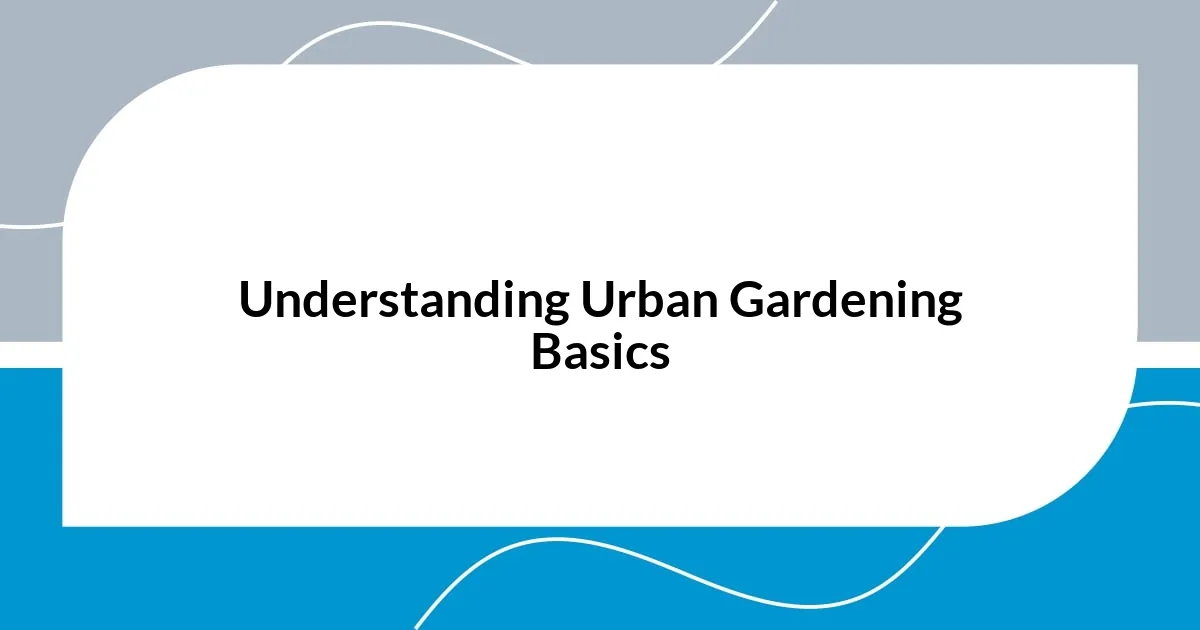
Understanding Urban Gardening Basics
Urban gardening is more than just a trend; it’s a grassroots movement that connects individuals to their food sources. I remember my first attempt at starting a balcony garden; I was overwhelmed by choices, from herbs to vegetables. The thrill of watching those tiny seedlings sprout was nothing short of magical, and it made me realize how rewarding this journey could be.
One of the foundational aspects of urban gardening is understanding your space. Whether you have a small balcony or a community plot, maximizing what you have is key. I often ask myself, “How can I make this space not just functional, but also beautiful?” The local flowering plants and vegetables I chose transformed my plain balcony into a vibrant oasis, proving that even a little can go a long way in creating an inviting environment.
Soil health is another critical component that can’t be overlooked. When I first started, I made the mistake of using generic potting soil—big mistake! After researching and switching to a rich organic blend, my plants thrived, and I felt more connected to the natural cycle of growth. Isn’t it fascinating how a simple change can lead to such profound results?

Selecting the Right Plants
Selecting the right plants can feel daunting, but it’s a pivotal part of creating a successful urban garden. I still remember the excitement I felt picking out my first herb plants at a local nursery. I went for what caught my eye—basil, rosemary, and mint—but as I learned, it’s essential to consider both your climate and the available sunlight. These factors can make or break your gardening experience.
When choosing plants, keep these tips in mind:
- Know Your Space: Understand how much sunlight your area receives daily.
- Consider Seasonal Changes: Some plants thrive in summer while others prefer cooler conditions.
- Select Companion Plants: Certain plants enhance growth when planted together; for instance, tomatoes and basil are great allies.
- Mind Your Maintenance: Choose plants that fit your gardening style—some require more attention than others.
- Leverage Local Knowledge: Visit community gardens or local gardening clubs to gain insights on what works best in your area.
Each of these insights has shaped my gardening journey. I’ve had my fair share of failures, especially with plants that weren’t suited for my little corner of the city, but those experiences have been invaluable. They taught me to appreciate the attributes of the plants that thrive and keep me inspired to learn more.
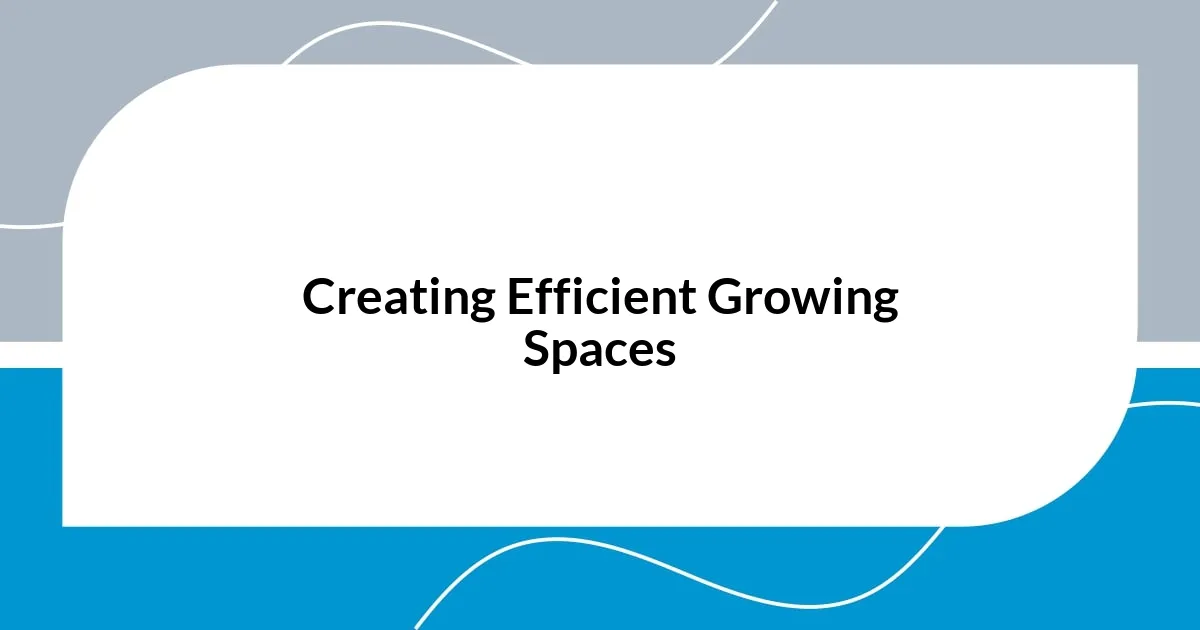
Creating Efficient Growing Spaces
Creating efficient growing spaces is an art that blends creativity with practicality. I recall when I first tackled my small, shaded patio; it felt like a challenge. However, by experimenting with vertical gardening techniques and utilizing wall planters, I transformed that overlooked area into a lush green haven. It was incredible to see how maximizing vertical space could dramatically increase my yield while adding depth to my urban oasis.
One of the most significant lessons I learned was about container gardening. I started with a few mismatched pots, unsure if they would work. As I researched, I discovered the importance of choosing the right container materials, sizes, and drainage features. Now, I prefer terracotta pots because they allow for airflow and moisture retention, helping my herbs thrive. Have you ever felt the satisfaction of nurturing plants that flourish in a well-designed space? It’s truly fulfilling!
In addition, I found that organizing my plants strategically can create a harmonious growing space. I experienced firsthand the benefits of clustering companion plants together. For example, planting my tomatoes alongside marigolds not only enhanced their growth but also kept pests at bay. Creating this synergy amongst my plants turned my garden into a balanced ecosystem, which deepened my connection to the gardening process.
| Technique | Description |
|---|---|
| Vertical Gardening | Utilizes wall space to grow plants upward, increasing yield in limited areas. |
| Container Gardening | Uses various pots and containers, allowing for flexible placement and styles. |
| Companion Planting | Plants selected for mutual benefits, enhancing growth and reducing pests. |
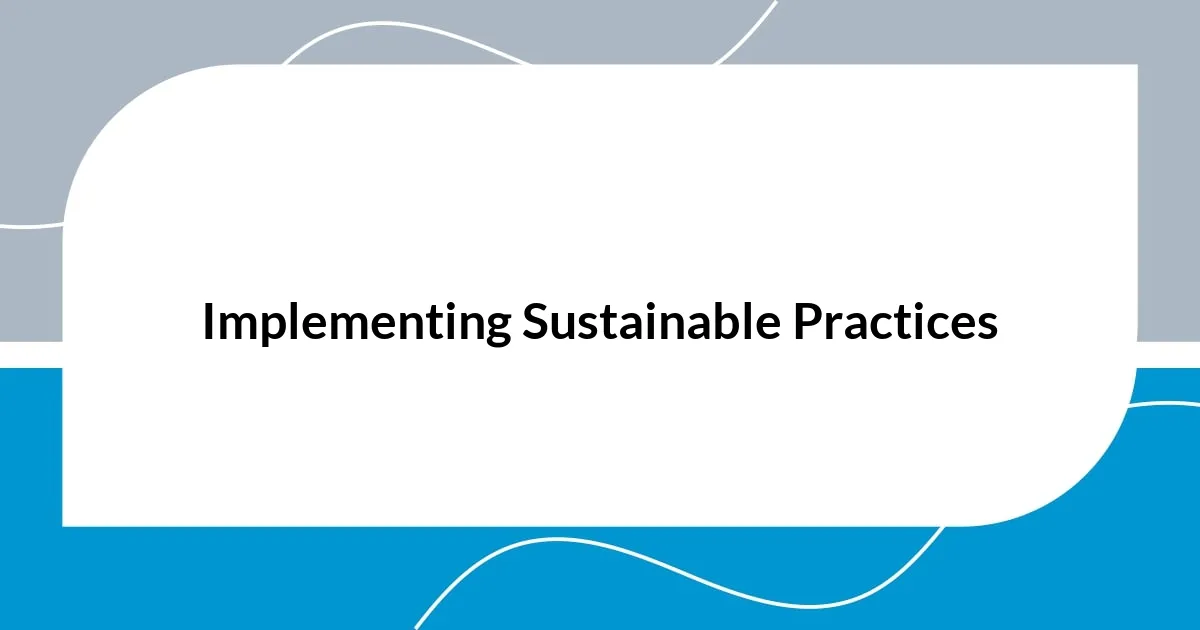
Implementing Sustainable Practices
Implementing sustainable practices in urban gardening has profoundly changed my approach to cultivation. I vividly recall the moment I decided to switch to organic fertilizers; the sheer joy of watching my plants respond positively was exhilarating. It’s a reminder that nurturing the soil health not only boosts plant growth but also contributes to the environment. Have you ever thought about the impact of what you’re using on your plants?
One method I embraced is composting. I started with a small bin in my kitchen and, to be honest, I initially struggled. Watching food scraps transform into nutrient-dense soil was like magic. The satisfaction I felt when using this compost in my garden was incomparable—seeing it foster vibrant plants was a testament to the power of recycling and giving back to the earth. It’s incredible how simple actions can lead to such valuable results.
Moreover, water conservation is an essential part of my gardening routine, especially in a city where every drop counts. I invested in a rainwater collection system, and I can’t express how rewarding it has been. Each time I fill my watering can with harvested rainwater, I feel a connection to the natural cycles. Have you considered how much water goes to waste? Implementing these practices not only makes you feel like a steward of nature but also creates a lasting impact on your community.
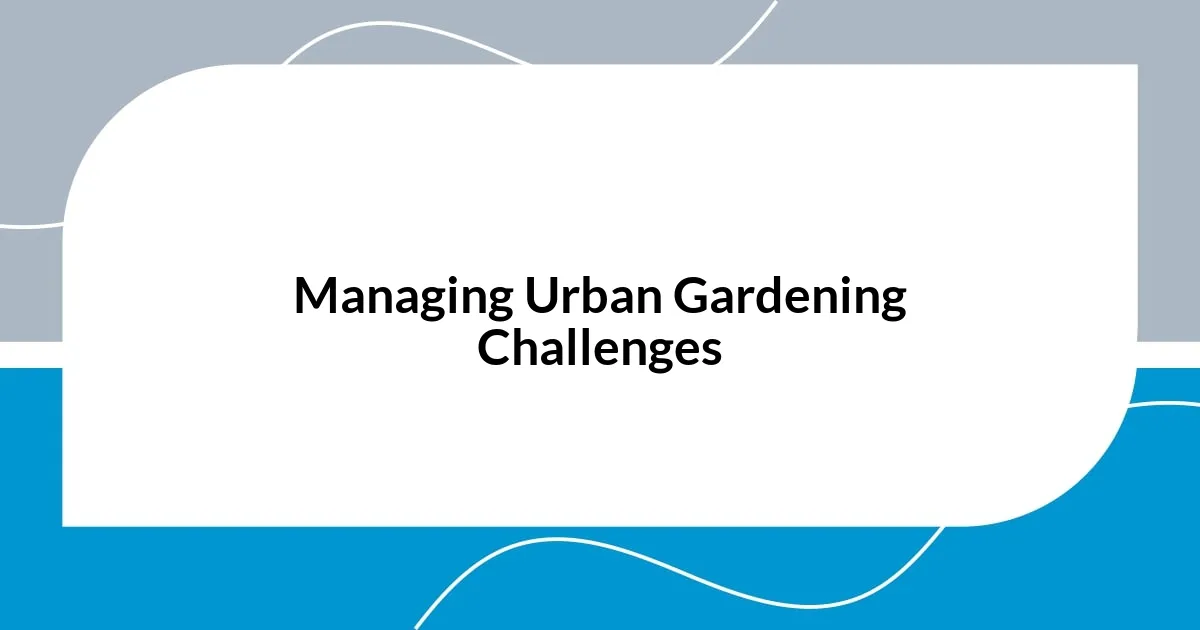
Managing Urban Gardening Challenges
Managing urban gardening challenges has its share of ups and downs. I remember one summer when pest control became a real headache. At first, I relied on store-bought sprays, but I quickly realized they weren’t the answer. A shift to natural repellents made a world of difference. I started spraying a homemade mix of garlic and chili, which not only kept the bugs away but also felt more in tune with my gardening philosophy. Have you ever found a little solution that just clicked? It made me appreciate the harmony between nature and gardening.
Another challenge I faced was dealing with limited sunlight. My balcony only received a few hours of direct light each day, and I feared my plants would struggle. Instead of giving up, I researched shade-tolerant varieties and discovered the beauty of leafy greens like kale and Swiss chard. Interestingly, I found that growing these plants turned my garden into a vibrant tapestry of greens, which became a favorite conversation starter with my neighbors. Isn’t it fascinating how adapting can lead to new discoveries?
I also struggled with soil quality, a common issue in urban settings. Initially, I used whatever soil mix seemed convenient, but my plants didn’t thrive. After some trial and error, I learned to create my own fortified mix with compost and organic matter. The transformation was astonishing. Each time I dug my hands into that rich, dark soil, I felt a genuine connection to the earth. It’s a reminder that, sometimes, the effort we put into understanding our environment pays off in ways we never expect. How often do we overlook the foundational elements of our gardening? Investing in quality soil truly changed the game for me.
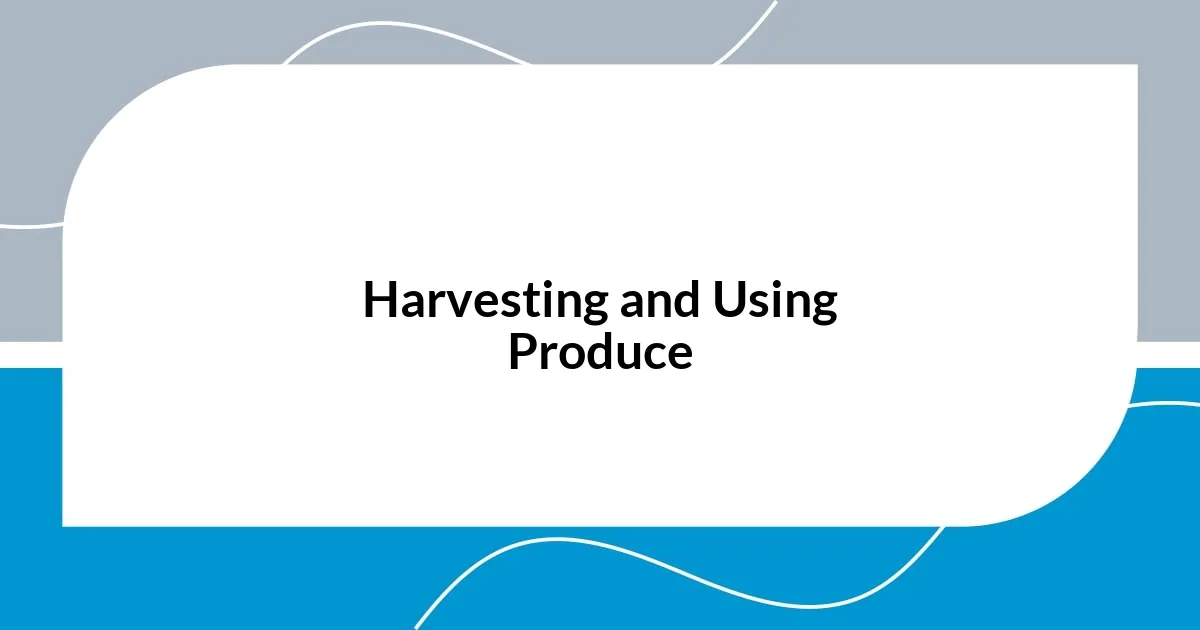
Harvesting and Using Produce
Harvesting from my urban garden has been one of the most rewarding experiences I’ve had. Each time I pull a ripe tomato from the vine, I can’t help but feel a thrill of accomplishment. It’s amazing to think that all that nurturing has paid off so deliciously. Have you ever tasted a homegrown tomato? There’s simply no comparison to the store-bought version. The flavor is vibrant and fresh, making every bite feel like a mini celebration.
Using the produce I’ve grown has been an adventure in itself. I remember the first time I turned my basil into homemade pesto. The aroma filled my kitchen like a warm hug, and when I tasted it, the satisfaction was almost overwhelming. It truly captured the essence of summer in every bite. I’ve also opted for simple dishes that showcase the freshness, such as salads tossed with whatever greens are ready to harvest. Have you ever discovered a recipe that just fits your harvest perfectly? The joy of experimenting with fresh ingredients is something I cherish.
Additionally, I found that sharing my excess produce with friends and neighbors deepened my community connections. One sunny afternoon, I offered a basket of cucumbers to a neighbor I’d only exchanged pleasantries with before. Their gratitude and enthusiasm sparked a lovely conversation, and now we often swap recipes. It’s not just about growing food; it’s about fostering relationships through that shared love of what we cultivate. Isn’t it incredible how urban gardening can bring people together? That’s a lesson I’m grateful to have learned.
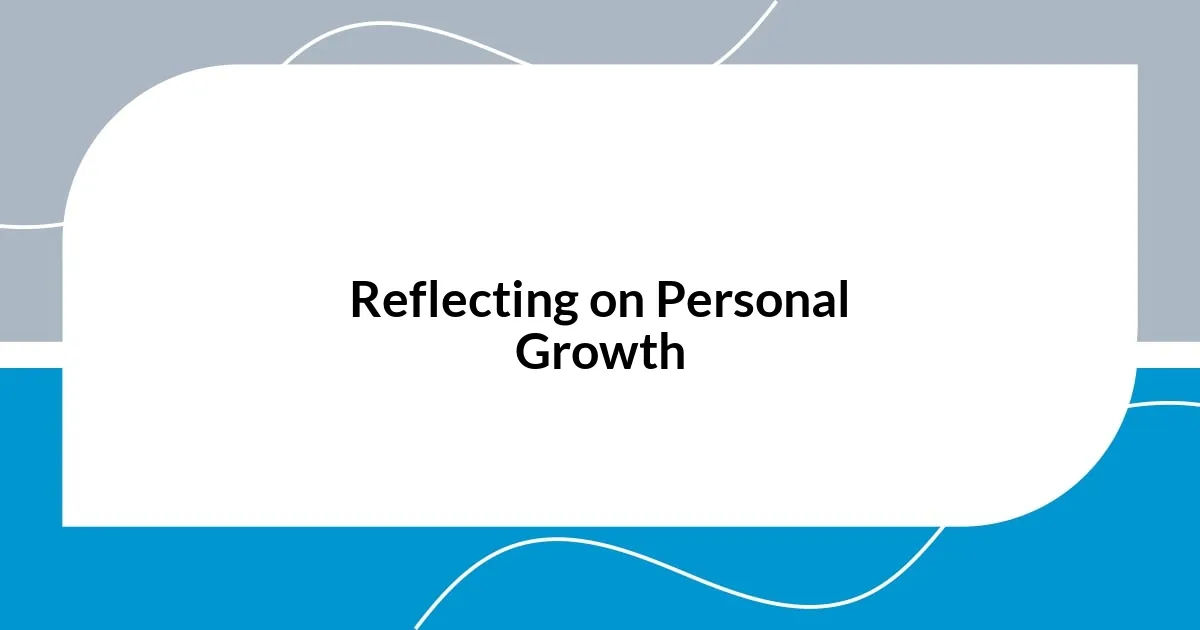
Reflecting on Personal Growth
Reflecting on my journey through urban gardening, I’ve realized the profound impact it has had on my personal development. One day, while weeding my garden, I found myself lost in thought about the patience it requires. I used to be so quick to give up when things didn’t go as planned. Now, with every stubborn weed I pull, I remind myself that persistence often leads to the most rewarding outcomes. Have you ever noticed how challenges can shape your character?
As I nurtured my plants, I discovered that this hobby was a mirror reflecting my own growth. There was an afternoon where I felt overwhelmed by the endless tasks—watering, pruning, and planning. But instead of succumbing to stress, I took a deep breath and focused on one plant at a time. This simple act transformed my mindset into one of mindfulness. It taught me that in life, as in gardening, focusing on the present moment can bring clarity and a sense of peace. How often do we forget to slow down and simply appreciate the process?
Interacting with my garden also deepened my appreciation for the cycle of life and the importance of nurturing growth, both in plants and in myself. I remember a rainy day when I was tending to some seedlings. As I watched the raindrops nourish them, I realized that just like those plants, we need the right environment to thrive—support, care, and encouragement. This experience has driven home the importance of self-compassion and allowing myself the grace to grow at my own pace. Isn’t it fascinating how something as simple as gardening can teach us such profound lessons?